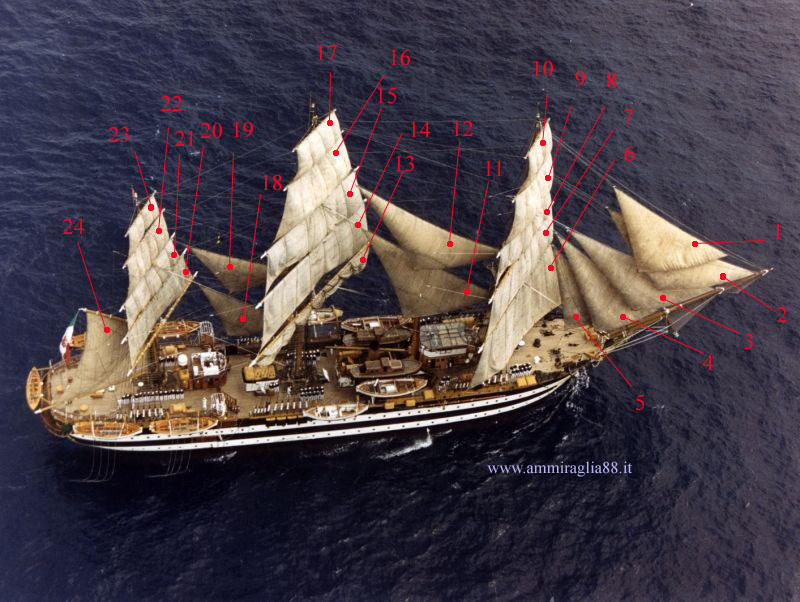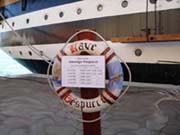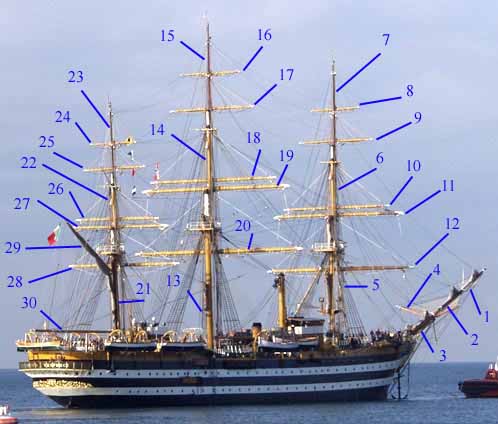
The vast sails.

| n° | sail | mq | n° | sail | mq | n° | sail | mq |
| 1 | "augelletto" | 99 | 9 | foremast topgallant sail | 93 | 17 | main royal | 49 |
| 2 | flying jib | 105 | 10 | foremast royal | 49 | 18 | mizzen stay | 47 |
| 3 | jib | 99 | 11 | crow's nest stay | 102 | 19 | mizzen topgallant stay | 45 |
| 4 | big jjb | 108 | 12 | crow's nest topgallant | 104 | 20 | mizzen topsail | 81 |
| 5 | fore staysail | 66 | 13 | main course | 345 | 21 | "against" mizzen "flying" | 58 |
| 6 | foremast course | 230 | 14 | main topsail | 187 | 22 | mizzen topgallant sail | 58 |
| 7 | foremast topsail | 166 | 15 | crow's nest "flying" | 139 | 23 | mizzen royal | 32 |
| 8 | fore-topsail "flying" | 110 | 16 | main topgallant sail | 115 | 24 | driver or spanker | 145 |
The sails are of two types: there are some square sails and some lateen sails.
The square sails are those on the yards, on nearly all the yards; there is an exception, in fact the greater one of mizzen that is the only one that is lacking. The square sails, are cross-sectional to the longitudinal axis of the ship.
The stays, the jibs and the gaff sail have Lateen sails. Their form is triangular and they are parallels to the longitudinal axis. The sails take the name from the mast that give the relative yard. The mizzen yard is without sail and for this is called “verga secca”. It is unprovided because the sail on this mast would remove wind to the larger sail, the main course. This is also the larger sail in this ship.
The always ready sails to the use are the five on bow, they are called “augelletto”, flying jib, jib, big jib and fore staysail, united to the four of stay, crow's nest, top gallant, mizzen and mizzen topgallant, and gaff sail on the extremity. If it is necessary, they are added the lower studding-sail. These are two square sails, they are used to sides of the foresail course, on appropriate extends of the yard.
When the sails is completely opened, the ship go much fast; the speed is remarkable, considering also its weight! The speed record is of 14,6 nodes. It has been established from the admiral Agostino Straulino, to the commando of this ship in the Cruise of Instruction 1965, on the crew there was the Students of the Kon-Tiki Course.
The surface total of the sails is approximately 2.635 square meters. They are of canvas, (woven of hemp) and have the thickness between the 2 and 4 millimeters. They are composed from the union, by means of seam, of more strips, called “ferzi” (cloths).
 |
 |
The masts and the yards.

The masts are four, in fact the bowsprit can be considered to all the effects a fourth mast, and are called:
bowsprit
compound from pieces - logs n° the 1 - 2 - 3 - 4
foremast
compound from pieces - logs n° the 5 - 6 - 7
mainmast
compound from pieces - logs n° the 13 - 14 - 15
mizzenmast
compound from pieces - logs n° the 21 - 22 - 23
| n° | mast - yard | meters | n° | mast - yard | meters | n° | mast - yard | meters |
| 1 | "against" jib boom | 13 | 11 | fore topsail yard | 21,80 | 21 | mizzen mast | 23,043 |
| 2 | "greatest" boom | 17,90 | 12 | fore yard | 25 | 22 | mizzen topmast | 11,60 |
| 3 | bowsprit | 14 | 13 | main mast | 34,47 | 23 | mizzen topgallant mast | 11,20 |
| 4 | "buttafuori di briglia" | 4 | 14 | main topmast | 17,60 | 24 | mizzen royal yard | 6,70 |
| 5 | fore mast | 32,17 | 15 | main topgallant mast | 14,50 | 25 | mizzen topgallant yard | 9,40 |
| 6 | fore topmast | 16,30 | 16 | main royal yard | 9,70 | 26 | "against" mizzen "flying" yard | 13,25 |
| 7 | fore topgallant mast | 14,50 | 17 | main topgallant yard | 13,70 | 27 | mizzen topsail yard | 16 |
| 8 | fore royal yard | 7,30 | 18 | main crow's nest yard "flying" | 20,50 | 28 | mizzen yard | 18 |
| 9 | fore topgallant yard | 12,40 | 19 | main topsail yard | 24,50 | 29 | peak | 11 |
| 10 | fore topyard "flying" | 17,60 | 20 | main yard | 28 | 30 | driver boom | 16,50 |
The masts are all compounds from three parts; the first two pieces on all masts and on the bowsprit are in steel; the third part, fore topgallant mast on the vertical masts and auction of flying jib on the bowsprit, are instead in wood (called “douglas”). The parts in steel of the yards are constituted from sheets with the nails.
Every mast has five yards, and these follow the same system: the three inferiors, the gaff sail and the boom are in steel, while the two advanced ones are in wood, like in wood is also the peak. The two inferior yards of every mast are fixed, and can only rotate on the horizontal plane, while the three advanced ones can slide on the mast. These advanced ones is raised at the moment to explain the sails.
The masts are held in position thanks to steel cables that support them towards bow stays, sides shrouds and breast backstays. On the stays are inferred the jibs and the sails of stay.
The maneuver of the sails happens thanks to cables, of various diameter, for a total of approximately 20.000 meters; the maneuvers can be of two types: “fixed” (or standing rigging) and running rigging. The standing rigging are constituted from with of the ropes, and cables, that they have the scope to maintain, to withhold, and to fix in stable and long-lasting way the masts, the shrouds, the yards (also allowing same to the possibilities of guideline) and all the fixed equipment on board.
With running rigging called the other ropes, and the other cables, destined to being maneuvered in order to allow the guideline of the sails I lower, the closed of the jibs, the use of the several tackles on board, the mooring, the towing and all the other maneuvers inherent to the conduct of the ship. These ropes are in manilla, a fiber vegetable, with the exception of the sheets of the course (the three largest sails) that they are realized in nylon, in order to support the high effort. Also the cables have various names: halyards, in order to raise the yards you furnish and the "sails of cut", lever arms, in order to orient the yards, sheets and tacks, in order to respective fix the low angles of the square sails (leeward and windward), and "the clew up sail", in order to collect, to pick up, the sails on the yards.
The following photo, for obvious reasons (it is impossible for me to make similar photos), they come from the web site of the Italian Navy.
the masts and the yards |
in full sail |
in full sail |
the masts and the yards |
the masts and the yards |
the masts and the yards |
the ropes |
the ropes (the lateral patience) |
in full sail |
the masts and the yards |
the manoeuvres |
the manoeuvres |
the manoeuvres |
the manoeuvres |
to the arrival in port (on the yards) |
the manoeuvres |
the sails |
to repair a sail |
to repair a sail |
to the arrival in port (on the yards) |
previous |
following |